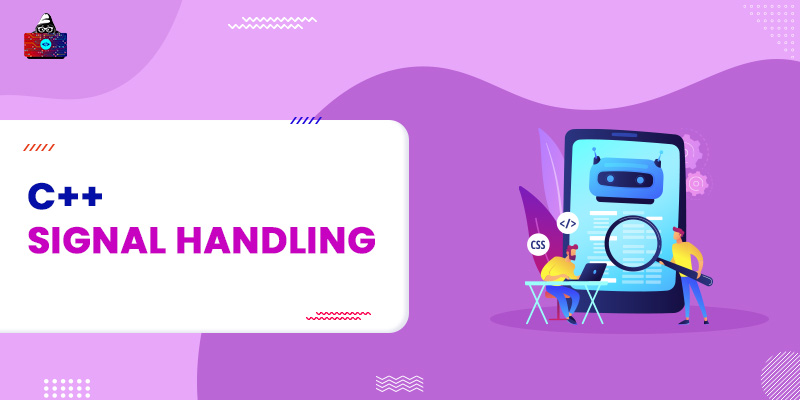In C++ we have the concept of signals, which are used to interrupt the ongoing task of the Operating System. Signals are basically messages given to the Operating System by the program to pause a service that is currently running on the operating system.
C++ Signal Handling
In C++ we can use a signal to pause or completely terminate a running program, C++ offers us with various signal here is the list of those:
| Signal | Description |
| SIGABRT | It can terminate a program abnormally. |
| SIGFPE | It can terminate a program if there is an error in Arithmetic Operations |
| SIGILL | It can be used to find out the invalid instruction |
| SIGINT | It can be used to show the receipt of an active signal or interactive program interrupt signal |
| SIGTERM | It sends a termination request to the program |
| SIGHUP | It shows the report if the user gets disconnected or terminated |
| SIGQUIT | It is used to terminate the process in order to generate a core dump |
| SIGTRAP | It is used to trace Traps |
| SIGBUS | It stands for Bus error and it is used to indicate a signal to access an invalid address. |
| SIGUSR1 | User-Defined Signal 1 |
| SIGUSR2 | User-defined signal 2 |
| SIGALRM | It indicates the expiration timer of a process |
| SIGCOUNT | This signal is used to make the process continue. |
| SIGSTOP | It is used to stop a process. |
We can also generate signals or interrupt in a running program by pressing Ctrl+C on a UNIX, LINUX, Mac OS X or Windows system. Every signal has a signal number and when we use the signal() function the signal number pass as an argument to the signal handler.
The signal() function
In C++ we have a signal-handling library that provides a function “signal()” that can be used to trap unexpected even. signal() is a built-in function of the signal-handling library so to use the signal function in our program we need to import signal library by adding the header file <signal.h>
Syntax
signal(signal, signal_handler)
Here the first argument signal must be one of the registered signals that we have mentioned in the above list, and the second argument signal_handler must be a function that handles the signal if there is an interruption. Example:
#include <iostream>
#include <signal.h>
using namespace std;
//signal handler function
//it will execute if there is an interruption in the program
//here s_n is the signal number
void s_h_func( int s_n )
{
cout << "You have press CTRL+C during the program execution "<< s_n << endl;
exit(s_n); //this statement will stop the program and terminal it
}
int main ()
{
signal(SIGABRT, s_h_func);
//infinite loop
while(1<2)
cout << "Tech Geek Buzz..." << endl;
return 0;
}
Output
Tech Geek Buzz... Tech Geek Buzz... Tech Geek Buzz... Tech Geek Buzz... Tech Geek Buzz... You have press CTRL+C during the program execution 22
Behind the code In the above program using the while(1<2) statement we have created an infinite loop but when your press CTRL+C during the program run time then, it will interrupt the program and the signal function catch that interrupt and generate a signal number and send it to the signal handler function s_h_func().
The raise function
The raise function is used to generate the signals, and it takes a signal number as an argument. Syntax:
raise(signal_number);
Example:
#include <iostream>
#include <csignal>
using namespace std;
void s_h_func( int s_n )
{
cout << "Interruption in the program has been encountered wiht signal number: " << s_n;
exit(s_n);
}
int main ()
{
int raise_point = 0;
signal(SIGINT, s_h_func);
while(1)
{
cout << "Tech Geek Buzz...." << endl;
raise_point+=1;
if( raise_point == 6 )
{
raise( SIGINT);
}
}
return 0;
}
Output
Tech Geek Buzz.... Tech Geek Buzz.... Tech Geek Buzz.... Tech Geek Buzz.... Tech Geek Buzz.... Tech Geek Buzz.... Interruption in the program has been encountered with signal number: 2
Behind the code In this example, we do not need to press the CTRL+c command to generate an interrupt here the raise() function did that for us. When the if(raise_point==6) statement get true the raise(SIGINT) function get triggered and it invoke the signal(SIGINT, signalHandler); function.
Summary
- Signals are the interrupts delivered to a process by the operating system.
- To generate an interrupt, we can press CTRL +C during program execution.
- In C++ we have a signal-handling library that provides a signal() function to trap unexpected events.
- The Signal-handling library also consists of a function raise() which is used to generate an interrupt.
People are also reading:
